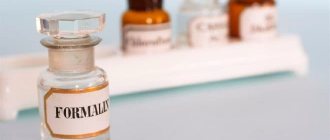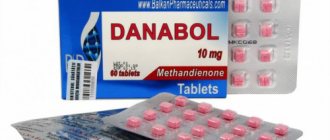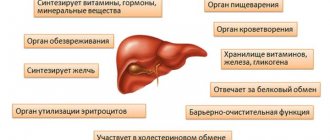Toxic poisoning of the body is a serious condition that is accompanied by disruption of the functioning of internal organs and systems. It develops under the influence of industrial poisons, household chemicals, and medications taken in excessive doses. Poisoning with toxic substances causes serious harm to the health of the victim, and sometimes leads to death.
What to do in case of toxic poisoning of the body?
Poisoning with toxic substances is the result of exposure of the body to poisons of chemical origin, surrogate alcoholic beverages, and food contaminated with bacteria.
The types of toxins and the ways they enter the human body are different. How poisoning by poisons manifests itself, what to do if intoxicated, how to protect yourself and loved ones from the effects of poisons - read the article.
Antidotes
These are drugs that are used to bind, neutralize and remove poisons from the body. For each intoxication, an individual antidote is prescribed that affects a specific toxic substance.
Antidotes are distinguished according to the principle of action:
The main condition is that the antidote must be administered no later than a certain time after poisoning. Delay or lack of an antidote can cause death.
The effect of taxins on the body
Deliberate poisoning of the body with toxic substances does not happen so often. Intoxication with industrial poisons mainly occurs as a result of an accident at work. Exogenous toxins enter the body through the respiratory tract, skin and mucous membranes.
Poisoning is caused by toxic substances of various types:
- chemicals used in agriculture - fertilizers, pesticides;
- carbon monoxide and lighting monoxide;
- heavy metals contained in the paints of children's toys;
- alcohol and its surrogates;
- medications taken in a toxic dose (such episodes more often occur when medications fall into the hands of a child);
- acids and alkalis;
- poisonous mushrooms;
- locally acting cauterizing agents – potassium permanganate, hydrogen peroxide;
- varnishes and solvents used in homes;
- spoiled food contaminated with bacterial poisons or aflatoxins from mold fungi.
In the pathogenesis of lesions, the route of entry of the poison into the body is important. Depending on this, the types of poisoning with toxic substances differ:
- Inhalation. Gasoline vapors, chlorine, carbon monoxide, ether, and hydrogen sulfide penetrate the respiratory tract. They have an irritating effect on their mucous membranes. Inhalation of alkali vapors contained in cleaning products often leads to household poisoning.
- Percutaneous poisoning. Volatile compounds, organophosphorus substances, and hydrocarbons are able to penetrate intact skin. These include mercury compounds, iodine, dichlorvos, karbofos, salicylic acid.
- Oral route of entry. Ethanol, benzene, medications, and organic acids are absorbed through the digestive tract.
- General intoxication of the body occurs when waste products of worms are absorbed from the intestines.
Percutaneous substances have a cauterizing effect on the skin. Alcohol and its surrogates are neurotoxins.
The mechanism of action of poisons on the body is associated with changes in metabolism. Most poisons cause oxygen deficiency - hypoxia. Thus, carbon monoxide, entering the body, replaces oxygen in the hemoglobin molecule, forming toxic carboxyhemoglobin.
Toxic poisoning is characterized by damage to the liver and stomach. The respiratory and vasomotor centers are inhibited. Cardiac arrest may occur and breathing rhythm may be disrupted.
Ways to remove toxins from the blood
When toxins enter the bloodstream, the body begins to get rid of them naturally. Removal occurs using:
- gastrointestinal tract;
- kidney;
- lungs;
- sweat, sebaceous and mammary glands;
- mucous membranes;
- skin pores
Some poisons can perform a kind of cycle in the body: together with bile, they penetrate from the stomach into the duodenum, and then are reabsorbed from the intestine. Such properties are characteristic of morphine and elenium.
To speed up the cleansing of the body from poisons and avoid serious complications, hardware methods are used:
- Dialysis is a procedure based on the properties of diffusion and convection. The “artificial kidney” device or the patient’s peritoneum acts as a membrane. On one side of the membrane there is the patient’s blood, on the other there is a special solvent. The exchange occurs due to the pressure difference between these two sides. Dialysis removes substances of various molecular weights, including toxins, and also equalizes water and electrolyte balance.
- Laser irradiation of blood. An optical waveguide is inserted into an accessible vein; then, with the help of equipment, red light with a strictly defined wavelength is supplied to it. The procedure reduces the level of blood toxicity, saturates cells with oxygen, strengthens the immune system, relieves swelling and inflammation. Laser irradiation of blood has a rejuvenating effect on the body and helps get rid of bad habits.
- Lymphosorption and hemosorption are methods consisting of perfusion of the patient’s blood or lymph through special columns (detoxifier). Columns filled with ion exchange resins or activated carbon are connected through a shunt into a vein or artery. The procedure is used to remove high molecular weight toxins, phenobarbital, salicylates, novocainamide.
- Hemotransfusion, or blood transfusion. One of the most ancient methods - used since 1628. To protect the recipient from possible infection, preliminary quarantine of the donor's blood components is performed.
- Plasmapheresis is a method that involves taking blood, purifying it by removing the plasma, and returning it to the bloodstream. It is carried out in different ways, depending on the nature of the toxic components.
During the recovery period, cleansing of the body can be accelerated by using medications, decoctions of medicinal herbs, and special exercises. But these methods are effective only after qualified medical care is provided.
Symptoms of toxic poisoning
Signs of poisoning are varied and depend on the nature of the poison and the route of entry into the body. Symptoms of toxic chemical poisoning:
- cold sweat;
- nausea;
- decrease in body temperature to 32°C;
- dizziness;
- vomit;
- headache;
- blurred vision (typical of botulism);
- difficulty swallowing;
- dilated pupils;
- lacrimation;
- copious amounts of saliva;
- drowsiness;
- cough, shortness of breath, difficulty breathing;
- disturbance of gait and coordination of movements;
- convulsions;
- loss of consciousness;
- If the poison enters the mouth, burns around the mouth may occur.
According to the condition of the victims, toxicologists distinguish 3 degrees of severity - mild, moderate, severe. According to the course, acute, subacute and chronic poisoning are distinguished.
The rate at which symptoms of intoxication occur depends on the route the poison enters the body. With food poisoning, diarrhea and abdominal pain appear after 1–3 hours. When toxic fumes are inhaled, signs of suffocation immediately occur.
Features of intoxication with various poisons
In case of toxic intoxication, it is important to determine what type of poison it is and take appropriate treatment measures.
Gas
The most common cause of fatal poisoning in everyday life is carbon monoxide, which is colorless and odorless. Sources include home stoves running on natural gas, fire stoves, and car interiors with poor ventilation.
The asphyxiating gas argon used during welding is dangerous. Poisoning by toxic vapors and gases is manifested by the following symptoms:
- headache;
- dyspnea;
- weakness;
- paleness, then blueness of the skin;
- an attack of angina caused by oxygen deficiency;
- convulsions;
- fainting;
- loss of consciousness;
- coma.
The effect of carbon monoxide on the brain is manifested by memory deterioration and impaired critical assessment of the situation. In case of severe poisoning, psychosis and parkinsonism are observed. These neurological symptoms develop over several days or even weeks.
Heavy metals
Lead, mercury, selenium, cadmium and arsenic, collectively called “heavy metals,” have a nephrotoxic effect and interfere with the biochemical processes of the body. They impair liver function and lead to the development of renal failure.
First aid for toxin poisoning
If you suspect contact with poisons, immediately call an emergency team.
Acute poisoning is accompanied by impaired blood circulation and breathing; disruptions in the functioning of the heart. Therefore, immediately provide assistance to the victim:
- In case of carbon monoxide intoxication, remove the person from the room and provide fresh air. Give the victim a soda solution to gargle.
- If acids or alkalis come into contact with your skin, first remove the substance with a cloth or tissue. Then wash the affected areas and eyes with running water and soap or a weak solution of baking soda.
- Apply a dry bandage to the eyes and affected parts of the body.
- If poison enters the mouth, rinse the stomach with soda solution. Place 1 tbsp per liter of water. l. soda Repeat the procedure 2-3 times until completely cleansed.
- Give the victim a water suspension of 10 crushed activated carbon tablets in a glass of water.
- Add enterosorbents - Filtrum, Polysorb, Smecta or Enterosgel.
Before doctors arrive, place the victim in bed on his side so that if he vomits, he will not choke.
Patient weight
1 heaped teaspoon of Polysorb contains 1 gram of the drug. 1 gram is the most recommended single dose for children. 1 heaped tablespoon of Polysorb contains 2.5-3 grams of the drug. 3 grams is the average single adult dosage.
Method of use of Polysorb for main indications
| Disease | Mode of application | Reception features | Number of receptions | Duration |
| Food allergies | Stir the powder depending on body weight in ¼-1/2 glass of water | During meals or immediately after | 3 times a day | 10-14 days |
| Chronic allergies, urticaria, hay fever, atopy | Stir the powder depending on body weight in ¼-1/2 glass of water | One hour before meals or one hour after meals | 3 times a day | 10-14 days |
| Poisoning | Gastric lavage with 0.5-1% Polysorb solution (2-4 tablespoons per 1 liter of water) | Next – oral administration of Polysorb suspension depending on body weight | 3 times a day | 3-5 days |
| Intestinal infections | Stir the powder depending on body weight in ¼-1/2 glass of water: 1 day - take every hour. Day 2 – dose four times a day. | Reception as part of complex treatment | 3-4 times a day | 5-7 days |
| Viral hepatitis | From the first days of illness, stir the powder depending on body weight in ¼-1/2 glass of water | Reception as part of complex treatment | 3-4 times a day | 7-10 days |
| Cleansing the body | Stir the powder depending on body weight in ¼-1/2 glass of water | One hour before meals or one hour after meals | 3 times a day | 7-14 days |
| Chronic renal failure | Stir the powder depending on body weight in ¼-1/2 glass of water | Reception as part of complex treatment | 3-4 times a day | 25-30 days |
| Toxicosis of pregnant women | Stir the powder depending on body weight in ¼-1/2 glass of water | One hour before meals or one hour after meals | 3 times a day | 10-14 days |
| P hangover | Day 1 – take 5 times a day every hour. Day 2 – take 4 times a day every hour. | Drink more fluids | 1 day – 5 times. Day 2 – 4 times. | 2 days |
| Hangover prevention | Take 1 dose: before the feast, before bed after the feast, in the morning. | 1 per day | 3 days |
Treatment of toxic poisoning
Patients after toxic poisoning of the body with acids, heavy metals or unknown poisons are treated by doctors in the toxicology department of a hospital or simply in the intensive care unit.
Sorbents and antidotes
Treatment of poisoning should be comprehensive:
- Tube gastric lavage.
- In case of acute heavy metal poisoning, a universal antidote, Unithiol, is administered.
- To bind and remove lead, DMSA-dimercaptosuccinic acid is given orally every 8 hours.
- Zinc is removed from the body by intramuscular injection of the antidote Dimercaprol.
- Carbon monoxide victims are given 100% oxygen through a machine. The antidote Acizol is administered intramuscularly.
- In case of poisoning through the digestive tract, the use of sorbents is especially important: Enterosgel, Smecta, Polyphepan, etc.
- Forced diuresis with Lasix.
- Plasmapheresis and hemodialysis are performed to purify the blood.
- If necessary, anticonvulsants, cardiac drugs, and respiratory analeptics are administered.
Drugs are used to correct acid-base balance. Further measures regulate the functioning of the heart and lungs.
Important Notes
In case of an alcohol overdose, the main thing is to pour as much liquid into the victim as possible, from 2 liters parenterally and from 3 liters orally. B vitamins are added to the dropper solution.- If symptoms of poisoning are observed regularly, small doses of the prescribed medication make you feel ill and a change in the drug is required.
- A syringe with the drug Athens in the first aid kit is for quick administration in case of poisoning with organophosphorus poisons, when the absence of this drug can cost life, and not for just use or sale.
- If a child is poisoned, a doctor should treat it. In children, symptoms may appear atypical or, conversely, extensively.
One way or another, at the first signs of poisoning, witnesses to what is happening only need to call an ambulance and provide first aid on the spot. Everything else is the concern of specialists.
Consequences of poisoning
The immediate consequences of chemical poisoning depend on the dose of poison entering the body.
A large dose is lethal to humans. Death occurs with acute cardiac and respiratory failure.
Intoxication with heavy metals leads to extremely negative long-term consequences:
- development of malignant tumors;
- damage to the reproductive system;
- congenital malformations of the fetus in pregnant women.
Acids upon contact with tissues cause burns of varying severity (depending on the amount drunk). After 1-2 sips of the essence, a severe burn of the esophagus occurs with a painful shock, from which they die without medical help.
Possible complications
Lack of timely treatment can lead to the development of the following complications:
- gastrointestinal perforation, bleeding, peritonitis;
- aspiration pneumonia;
- toxic shock;
- acute renal and liver failure;
- coma;
- death.
In the delayed period, negative consequences may occur such as:
- allergic reactions;
- complications during pregnancy (congenital deformities, fetal death);
- formation of malignant tumors;
- development of chronic diseases of internal organs;
- reproductive dysfunction.
Intoxication of the body is a dangerous condition that can lead to death. Symptoms in adults and treatment depend on the type of toxic substance causing the disorder. The most important factor determining the success of therapy is the accurate identification of the cause of poisoning and timely provision of first aid to the victim.
Article design: Mila Friedan
Prevention
It is difficult for a city person to avoid contact with heavy metals and chemicals. They enter our lungs with car exhaust gases. Penetrates into the stomach along with tap water. You can always limit their intake by following certain rules:
- drink bottled water;
- go out of town for the weekend;
- do not use antiperspirants, deodorants;
- Do not cook food in aluminum foil;
- replace amalgam fillings.
How does a toxic substance enter the body?
All toxic poisonings are divided into two large categories:
- exogenous - the poison enters the body from the outside;
- endogenous - the toxin is formed due to pathological processes inside the body.
Exogenous poisoning can be either accidental or intentional - for the purpose of committing suicide, to satisfy curiosity, to achieve euphoria. There are several ways for poisons to enter the body:
- oral – through the mouth;
- percutaneous – in case of contact with skin;
- inhalation – inhalation of vapors of gasoline, glue, household, carbon or other monoxide;
- parenteral - through the blood (with an insect or animal bite, intramuscular or intravenous administration);
- intracavitary - through the vagina, rectum, external auditory canal;
- through the mucous membrane.
Endogenous poisoning is a consequence of a disease: infection, malignant tumor, blood disease, liver disease, and other pathologies. Skin lesions from burns also lead to such intoxication: when tissue necrotizes, toxins are formed that enter the blood. Most often, it can be resisted only after appropriate treatment.
Acute toxic poisoning is a consequence of a single exposure to a toxin in high concentration. If the poison acts on the body regularly, but its dose is small, chronic intoxication develops. It can also result from ending therapy too hastily.
How toxins affect the body
Toxic substances are carried throughout the body through the blood. But the speed of blood flow near the internal organs is significantly different. Where it is higher, the effect of the poison will be more noticeable.
Some toxins are similar in structure and characteristics to substances found in the body. The poison displaces them and interferes with metabolism. As a result, dysfunctions of various systems begin.
Some poisons, once inside, undergo biotransformation: they react with enzymes and form so-called metabolites. For example, less harmful codeine turns into dangerous morphine. This process is called “lethal synthesis”: it is the new, transformed substance that causes harm to the body.
Classification of toxic substances
Classification by source of poison:
- household (paint and varnish products, household chemicals;
- agricultural (insecticides, fertilizers);
- medicinal;
- industrial;
- biological (plants, animals);
- chemical (gases).
Classification by chemical nature:
- Poisons of organic origin. The result of the vital activity of living organisms. They are divided into poisons of animal (snakes, spiders, etc.), plant (mushrooms, berries, etc.) and microbial origin (botulinum toxin, etc.)
- Poisons of inorganic origin. They have a wider affected area. These are salts of some metals, acids, alkalis, etc.
Classification according to the nature of the effect on the body:
- Neurotoxins. Nerve fibers and the brain are affected, the person falls into a coma or dies from cardiac arrest. Such poisons include narcotic substances, counterfeit alcohol, carbon monoxide and medications, and the venoms of some spiders and snakes that paralyze the victim.
- Cardiotoxins. Affects the cardiovascular system. These poisons include cardiac glycosides and substances secreted by some plants (columbine, lily of the valley, hellebore) and animals (fish, frogs, snakes). Intoxication leads to heart failure and complete cardiac arrest.
- Hepatotoxins are chemicals that cause pathological changes in the liver. These are aldehydes, phenols, halogens, metals and their salts, chlorocarbons. A striking representative of the source of such poison is the pale grebe.
- Nephrotoxins damage the kidneys, causing kidney failure. These are salts of heavy metals, technical alcohol, poisonous mushrooms, medications, etc.
- Hematotoxins are chemical compounds that cause damage to red blood cells in the human body. These are nitrites, aniline.
- Gastroenterotoxins affect the gastrointestinal tract. The main poisons of this group are alkalis, acids, salts of heavy metals, and arsenic.
Classification by method of injury:
- Poisoning through the respiratory system occurs when volatile substances such as gasoline vapors, carbon monoxide, and ethers enter the lungs.
- Through the mouth if swallowed. Toxins enter the body through the mouth, are absorbed into the gastrointestinal tract through the mucous membrane and penetrate into the blood (poisonous mushrooms, drugs, ethanol).
- Toxic substances penetrate when injected intravenously, intramuscularly or subcutaneously.
- Through the skin (mercury).
- Penetration through the mucous membrane.
- Penetration of poison into the body through the vagina, ear, rectum.
Classification by degree of toxicity:
- low toxic;
- moderately toxic;
- highly toxic;
- extremely toxic.
The classification of a particular poison into a particular group depends on the characteristics of the human body, the amount of poison and environmental conditions. Depending on the dose, type of toxin, and method of penetration of the poison, intoxication causes different symptoms in different people.
When poisoning with toxic substances, it is important to determine what type of poison it is and take appropriate action.
Symptoms of poisoning
Toxins affect the body's internal systems in different ways. The symptoms of illness depend on what kind of poison caused the toxic poisoning. The speed at which the first signs of illness appear is affected by the solubility of the substance, the method of its penetration, dosage, and individual characteristics of the body.
General symptoms of acute intoxication include:
- suffocation;
- slow or accelerated inhalation and exhalation;
- toxic pulmonary edema;
- tearfulness;
- skin rash;
- temperature increase;
- nausea;
- vomiting;
- diarrhea;
- pain in joints and muscles;
- neuropsychiatric disorders;
- heart rhythm disturbances;
- drop in blood pressure;
- pain in the heart area;
- paleness of the skin;
- decrease in the amount of urine excreted, its darkening;
- convulsions;
- depression of consciousness;
- to whom.
Chronic intoxication manifests itself:
- constant fatigue;
- drowsiness;
- irritability;
- regular headaches;
- unsteady gait;
- lack of appetite, indigestion.
At home, it is permissible to help with mild toxic poisoning. If you notice several symptoms at the same time, calling a doctor is mandatory.
Diagnosis of body intoxication
Diagnosis of intoxication is not difficult; it can be much more difficult to determine the type of toxin that caused disruption of body functions. For this purpose, they resort to laboratory tests aimed at detecting the toxin itself or its metabolic products in the biological fluids of the body.
A biochemical blood test is carried out, the results of which make it possible to identify changes in the functions of systems and organs associated with exposure to toxic substances.
Diagnosis is made based on medical history and characteristic clinical signs. To determine the type of poison that caused intoxication, a laboratory test is carried out to identify toxins directly or the products of their metabolism in the blood and other biological fluids.
In the case of a chronic form of the pathology and the presence of complications, additional instrumental examinations are prescribed to determine the nature of changes in the functioning of internal organs and systems (ultrasound, radiography, FGDS, CT and others).
Differential diagnosis is carried out with the following types of diseases:
- neuroinfections (meningitis, encephalitis);
- hyper- and hypoglycemia;
- traumatic brain injury;
- stomach ulcer, duodenal ulcer and other pathologies.
First aid for poisoning
First aid for toxic poisoning should be immediate. It is aimed at accelerating the removal of poisons. If the toxin is ingested through the digestive tract, pre-medical measures include:
- gastric lavage;
- intestinal lavage;
- drinking plenty of water;
- taking enterosorbents.
It is forbidden to induce vomiting if:
- a child under 5 years of age was poisoned;
- the victim is unconscious or in a coma;
- toxic substances have cauterizing properties.
If the poison gets on the skin, wash the area with clean water. In case of inhalation poisoning, the victim is taken to clean air. You can loosen or remove tight clothing to clear your airway.
What not to do
In case of toxic poisoning, there are a number of actions that absolutely cannot be performed:
| Name of toxic substance | Prohibitory measures |
| Vinegar | Use a solution of water and soda to rinse the stomach. Forcefully induce vomiting. |
| Food poisoning | Self-medicate, determine the diagnosis on the Internet. |
| Alkali (ammonia, lime, caustic soda) and acids. | Force vomiting, rinse the stomach with a soda solution, give a laxative and water. |
| Alcohol | Place the patient on his back, give sparkling water and a laxative. |
| Medical preparations | Leave the patient alone and allow him to shower. |
| Petrol | Induce vomiting. |











